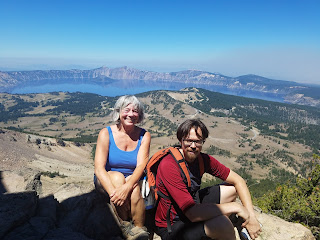First we climbed Mt. Scott – about 4 1/2 miles (up and back), gaining 1,259 feet in altitude. Mt. Scott reaches an altitude of 8,934 feet. The views are stupendous.
 |
| With Ela, on top of Mt. Scott on my 74th birthday |
 |
| Mike: "Did you see what just happened to Ela?" |
How I love Crater Lake! In most high-altitude lakes, the lake is blue, but to swim in it is to swim through ordinary, clear water. Swimming through Crater Lake is like swimming through color itself. An inch from my fingertips the water was still like rich blue paint. I swam till I was far from shore and the squeals and splashes of people jumping into the lake had dimmed with distance. I felt like I could swim to Wizard Island if it weren't that I would have to swim back, too.
The next day, defying the smoke, Mike, Ela, and I hiked the Cameron Meadows/Frog Pond loop in the Red Buttes Wilderness (in my "back yard"). As we started the hike, in visible if thin smoke, Mike told me this would probably take two years off my life. I told him to remind me, when I'm dying at the age of 98, that I would have lived for two more years if it hadn't been for that hike I took on my 74th birthday.
The trail was steeply rigorous. Mike's mosquito repellent saved our tempers. The meadows at the top were colorful with wildflowers – white yarrow, yellow Oregon sunshine, pink vinegar weed, red Indian paintbrush.
On the way down the mountain, I started thinking about what to do for my 75th birthday, a landmark number. As I walked, I had a light-bulb moment: Between now and July 20, 2019, I thought, I could do 75 things of 75 repetitions each. Things like:
Write 75 people to ask for suggestions of 75 things to do
Do a 75-mile hike
Write 75 poems
Do 75 good deeds
Brilliant.
Crazy.
The more I thought about it, the more elaborate it got. Make 75 cards to send to 75 friends on my birthday. Bake 75 desserts. (Let's see. That would be a different dessert every five days ….) If I had 75 items on the list, each of which had 75 parts to it, I would have to do 15 parts every day for a year – make one dessert, make one card, write one poem – yeow! What happened to ordinary life?
Stupid.
Crazy.
But possible? And fun! So I wrote the 75 friends and asked for suggestions, hinting that things like "Do an embroidery with 75 stitches" would be more feasible than "Read 75 books." I said I needed things that could be done in hours rather than days. "Be reasonable," I said. "I can't plant 75 trees in a year and do everything else on the list, too, and I'll never do 75 push-ups."
Suggestions and comments poured in. Most people loved the idea. (Two people advised me to abandon it.) I enthusiastically embraced most of the suggestions but decided not to memorize the first 75 digits of pi. That would be like doing 75 push-ups – though, come to think of it, I wouldn't mind memorizing a 75-line poem. I especially liked the suggestions that benefitted other people – do 75 acts of kindness, make 75 prayers for the earth. I now have 54 items on the list, which you can view on my new blog, thingstodoinmy75thyear.blogspot.com. It'll keep interested readers informed of my progress.
Do you want to join the fun? Send me your ideas! I still need 21 more.









